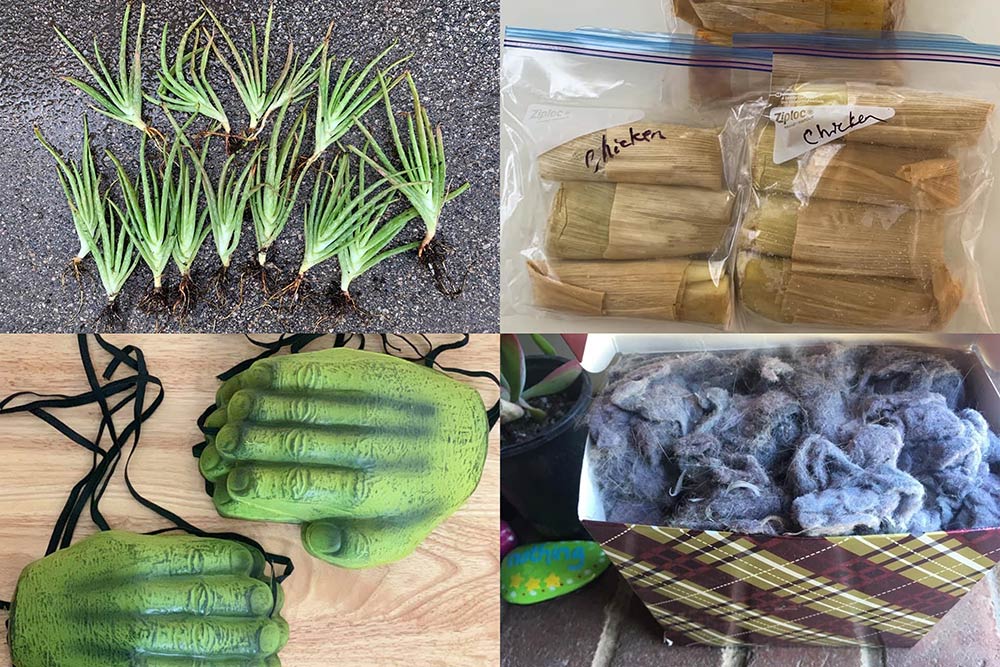
2018年,免费赠物的想法吸引了雷蒙娜•蒙特罗斯,于是她加入了洛杉矶当地的“无消费”(Buy Nothing)小组。她说:“卖东西是件麻烦事,我不想讨价还价。” 她在 Facebook小组发布了不再使用的物品——孩子长大后不再适合的衣服和鞋、清理庭院时想处理掉的多肉植物——邻居会在小组里认领,然后顺便来她家取走。
当时小组只有40名成员,蒙特罗斯很快就成了小组管理员,负责确认申请入组的成员住在规定的街区、清理垃圾贴文,还有组织活动和鼓励人们互动。小组保持着相对较小的规模,到2020年初成员增长到约400名。
接下来,新冠疫情爆发了。初期,由于成员对病毒传播问题议论纷纷,于是商量关闭小组。到最后,他们决定宁愿在门廊或前廊与邻居以物换物,也不去商店购物。蒙特罗斯认为,这么多人失业,经济状况又不稳定,保持“无消费”感觉是一种道德义务。

成员间赠予的玩具和童装是大多数“无消费”小组主要的交换物品,但他们也交换疫情期间的必需品,如酸面团、口罩和手套、气泡膜和纸箱。在附近克莱蒙特的一个小组,甚至出现了被用作打火器的干棉絮,有些计划在疫情期间露营的人会来认领。而在托兰斯,一个生日快乐的草坪标牌,被发到蒙特罗斯朋友经营的小组里广为传阅。蒙特罗斯说:“在最初的几周里,疫情真的把大家聚集在一起。”
一年后,这个由北好莱坞居民组成的小组已有1800多名成员,新增了7名管理员才能管理发帖。小组发展得如此之大,为避免变得过于臃肿,小组最近被一分为二了(这在“无消费”圈里被称为“发芽”)。
需要清楚说明地是,礼物经济的兴起,并不是洛杉矶的特有现象。从2020年3月到2021年1月,被发起人称为社会运动的“无消费”活动新增了150万名参与者,成员总计达到了400万。在另一个理念相似的组织Freecycle,用户发布的赠物帖在疫情期间增加了一倍。
当人们被隔离而无法正常社交时做出的清理房间行为,以及疫情带来的经济不确定性,都在推动这场运动发展。但专家认为,在过去的一年半里,随着人们坐在家中重新调整生活重心,大家的集体心理也发生了更深层的变化。研究消费行为的波士顿学院社会学教授、经济学家朱丽叶•肖尔说:“人们对消费文化及其运转方式越来越不满,对造成的浪费,以及从购买到丢弃的循环过程也越来越感到厌倦。”她称,这是人们反思消费主义时发生的“主流变化”。
瑞贝卡•洛克菲勒是“无消费”活动的联合发起人,她认为礼物经济的长久存在是有道理的。“这就是人类最初作为物种生存下来的方式。现在重新发现它的价值很有意义,因为我们正处于社会发展的转折点上,如何朝着未来的方向前进,我们需要做出很多思考,”她说。
这种转变在我的邻里社区里也得到了体现:疫情期间,邻居们成立了自己的“无消费”小组。有成员贡献自行车、慢炖锅和打印机,也有人同样乐于接收剩下的生日蛋糕、外卖餐具、塑料吸血鬼牙齿和使用了一部分的牙膏。去年5月,社区里还出现了一个专门用来交换拼图的本地Facebook群组——在当时,拼图的需求旺盛,而且很难找到。我的公寓留言板上发布了各种赠物信息,包括家具、空调和在线购买杂货时误订的多余食物。关注这些帖子让我了解到身边邻居们正在发生的事,在很容易感到孤立无援的时候,这些信息提供了一个了解别人生活的窗口。看到同样备受煎熬的人们都在做出贡献,这让我充满希望——而这,也是蒙特罗斯的经历。她说:“这让你感到更安全,感觉自己并不孤单。这是一种安慰。”
加埃勒•巴尔甘-达里格对此做了一项研究,发现这种联结感对“无消费”成员来说至关重要。波士顿学院的肖尔建议巴尔甘-达里格从迈阿密搬到新英格兰钻研社会学的博士课程,研究方向是消费和环境。当接受新邻居建议去查看本地小组有什么物品能布置新家时,她对“无消费”活动产生了兴趣——她为孩子挑选了物品,还有一把摇椅和布置阳台的家具。
巴尔甘-达里格想了解人们为何会加入其中,特别是在比较富裕的社区。对许多人来说,主要是担心浪费,同时也希望避免扔掉有价值的东西;其他人则是担心环境问题,或是有经济需要。但当听到人们谈论从小组里获得的主要价值时,她惊讶不已。“每个人都强调,这种做法营造了一种社区感,一种邻里之间的团结感。”
巴尔甘-达里格的研究里还有一个重要发现,那就是“无消费”小组其实并没有导致人们不消费。尽管试图限制和控制自己的消费,人们依然会购买新物品。
或许,这正是“无消费”的重点,甚至是吸引力之所在。几十年来,主流消费观的替代方案总在文化中循环往复——比如自愿简化消费、消费降级、极简主义、返璞归真的生活方式。但“无消费”理念更友好,更不走极端。参加这项活动并不会强迫任何人改变与资本主义或物质财富的关系,这有助于解释为什么活动能在早期核心成员以外发展起来。莉斯尔•克拉克是“无消费”活动的另一位联合发起人。她说:“你可以认为这是考虑可持续性的良心消费,但绝对也是一种消费行为。我们只是在分享资源,而不是一场节衣缩食的运动。”
克拉克和洛克菲勒于2013年在华盛顿州班布里奇岛发起了“无消费”活动,她们将其成长壮大的原因归功于代际转变。年轻的消费者更有可能不把二手商品视为一种禁忌,而是认为它们很酷且货真价实。波士顿咨询公司称之为“转售潮”,也进一步证明了这一点。该公司对转售市场(如eBay、Poshmark和Depop)的估值高达4000万美元,并预计未来五年内,每年还将增长20%。
作为X世代,洛克菲勒是意识到气候变化迫在眉睫的第一代人。她说,1970年代出生的嬉皮士后代所经历的环保活动通常认为人们必须受苦,才能让世界变得更好。“这并非一条实现可持续变化的好路子,”她解释说。“激励人们改变与物质关系的最好方法,是找到一种方式将人与人连接起来,并为整件事带来欢乐和乐趣。”
但也有人警告说,当蓬勃发展的礼物经济所需的联结感变得过于狭隘时,就会出现问题。新泽西理工学院研究可持续发展的教授莫里•科恩认为,有些人一开始愿意参与,可能只是因为他们想在社会经济群体中进行交流。他说:“我们不能忽视社会阶层分化的过程。”
2018年,波士顿牙买加平原社区的一个无消费小组宣布将要“发芽”。上述担忧变成了非常重要的问题,并导致人们对一分为二时可能带来的种族主义和阶级主义发出了谴责。洛克菲勒和克拉克说,这个“分水岭时刻”让她们开始反思,用硬性边界分离社区,可能会延续结构性的种族主义。此后,她们建立了一个公平团队,并给予本地社区更多自主权。当蒙特罗斯的小组“萌芽”时,她和其他管理员对成员进行了调查,并研究了人口数据和交通路线。然后,他们发布了全部信息供成员查看。
我问蒙特罗斯,随着疫情进入下一阶段,她的小组活动是否会变少。她说:“我自己也在思考这个问题。”她估计活动可能会放缓,但不会完全消失。“因为它已经成为了人们生活的一部分。”
有经济学家预测,传统消费在疫情之后将出现“反转”,这可能会减弱人们对类似“无消费”运动的热情。数据表明,人们已经在逐渐回归原有习惯。消费者在去年的支出下降了3.9%,但此后已超过了疫情前水平。印第安纳大学威尔明顿分校的人类学荣誉教授理查德•威尔克说:“经过很长时间的禁止外出用餐、饮酒和聚会后,人们通常会无节制地狂欢。这在我们的文化里已经存在几百年了。”
但他认为,即便是狂欢,人们如今也会在道德上保持克制。他说:“美国人是乌托邦式的思考者,也是狂野的派对动物。他们以一种奇怪的相互依赖关系走到一起。你无法离开另一个人。”(财富中文网)
译者:Emily
邻里间通过疫情中兴起的本地“无消费”小组,彼此免费赠予和接受物品。图片版权:GETTY IMAGES
2018年,免费赠物的想法吸引了雷蒙娜•蒙特罗斯,于是她加入了洛杉矶当地的“无消费”(Buy Nothing)小组。她说:“卖东西是件麻烦事,我不想讨价还价。” 她在 Facebook小组发布了不再使用的物品——孩子长大后不再适合的衣服和鞋、清理庭院时想处理掉的多肉植物——邻居会在小组里认领,然后顺便来她家取走。
当时小组只有40名成员,蒙特罗斯很快就成了小组管理员,负责确认申请入组的成员住在规定的街区、清理垃圾贴文,还有组织活动和鼓励人们互动。小组保持着相对较小的规模,到2020年初成员增长到约400名。
接下来,新冠疫情爆发了。初期,由于成员对病毒传播问题议论纷纷,于是商量关闭小组。到最后,他们决定宁愿在门廊或前廊与邻居以物换物,也不去商店购物。蒙特罗斯认为,这么多人失业,经济状况又不稳定,保持“无消费”感觉是一种道德义务。
成员间赠予的玩具和童装是大多数“无消费”小组主要的交换物品,但他们也交换疫情期间的必需品,如酸面团、口罩和手套、气泡膜和纸箱。在附近克莱蒙特的一个小组,甚至出现了被用作打火器的干棉絮,有些计划在疫情期间露营的人会来认领。而在托兰斯,一个生日快乐的草坪标牌,被发到蒙特罗斯朋友经营的小组里广为传阅。蒙特罗斯说:“在最初的几周里,疫情真的把大家聚集在一起。”
一年后,这个由北好莱坞居民组成的小组已有1800多名成员,新增了7名管理员才能管理发帖。小组发展得如此之大,为避免变得过于臃肿,小组最近被一分为二了(这在“无消费”圈里被称为“发芽”)。
需要清楚说明地是,礼物经济的兴起,并不是洛杉矶的特有现象。从2020年3月到2021年1月,被发起人称为社会运动的“无消费”活动新增了150万名参与者,成员总计达到了400万。在另一个理念相似的组织Freecycle,用户发布的赠物帖在疫情期间增加了一倍。
当人们被隔离而无法正常社交时做出的清理房间行为,以及疫情带来的经济不确定性,都在推动这场运动发展。但专家认为,在过去的一年半里,随着人们坐在家中重新调整生活重心,大家的集体心理也发生了更深层的变化。研究消费行为的波士顿学院社会学教授、经济学家朱丽叶•肖尔说:“人们对消费文化及其运转方式越来越不满,对造成的浪费,以及从购买到丢弃的循环过程也越来越感到厌倦。”她称,这是人们反思消费主义时发生的“主流变化”。
瑞贝卡•洛克菲勒是“无消费”活动的联合发起人,她认为礼物经济的长久存在是有道理的。“这就是人类最初作为物种生存下来的方式。现在重新发现它的价值很有意义,因为我们正处于社会发展的转折点上,如何朝着未来的方向前进,我们需要做出很多思考,”她说。
这种转变在我的邻里社区里也得到了体现:疫情期间,邻居们成立了自己的“无消费”小组。有成员贡献自行车、慢炖锅和打印机,也有人同样乐于接收剩下的生日蛋糕、外卖餐具、塑料吸血鬼牙齿和使用了一部分的牙膏。去年5月,社区里还出现了一个专门用来交换拼图的本地Facebook群组——在当时,拼图的需求旺盛,而且很难找到。我的公寓留言板上发布了各种赠物信息,包括家具、空调和在线购买杂货时误订的多余食物。关注这些帖子让我了解到身边邻居们正在发生的事,在很容易感到孤立无援的时候,这些信息提供了一个了解别人生活的窗口。看到同样备受煎熬的人们都在做出贡献,这让我充满希望——而这,也是蒙特罗斯的经历。她说:“这让你感到更安全,感觉自己并不孤单。这是一种安慰。”
加埃勒•巴尔甘-达里格对此做了一项研究,发现这种联结感对“无消费”成员来说至关重要。波士顿学院的肖尔建议巴尔甘-达里格从迈阿密搬到新英格兰钻研社会学的博士课程,研究方向是消费和环境。当接受新邻居建议去查看本地小组有什么物品能布置新家时,她对“无消费”活动产生了兴趣——她为孩子挑选了物品,还有一把摇椅和布置阳台的家具。
巴尔甘-达里格想了解人们为何会加入其中,特别是在比较富裕的社区。对许多人来说,主要是担心浪费,同时也希望避免扔掉有价值的东西;其他人则是担心环境问题,或是有经济需要。但当听到人们谈论从小组里获得的主要价值时,她惊讶不已。“每个人都强调,这种做法营造了一种社区感,一种邻里之间的团结感。”
巴尔甘-达里格的研究里还有一个重要发现,那就是“无消费”小组其实并没有导致人们不消费。尽管试图限制和控制自己的消费,人们依然会购买新物品。
或许,这正是“无消费”的重点,甚至是吸引力之所在。几十年来,主流消费观的替代方案总在文化中循环往复——比如自愿简化消费、消费降级、极简主义、返璞归真的生活方式。但“无消费”理念更友好,更不走极端。参加这项活动并不会强迫任何人改变与资本主义或物质财富的关系,这有助于解释为什么活动能在早期核心成员以外发展起来。莉斯尔•克拉克是“无消费”活动的另一位联合发起人。她说:“你可以认为这是考虑可持续性的良心消费,但绝对也是一种消费行为。我们只是在分享资源,而不是一场节衣缩食的运动。”
克拉克和洛克菲勒于2013年在华盛顿州班布里奇岛发起了“无消费”活动,她们将其成长壮大的原因归功于代际转变。年轻的消费者更有可能不把二手商品视为一种禁忌,而是认为它们很酷且货真价实。波士顿咨询公司称之为“转售潮”,也进一步证明了这一点。该公司对转售市场(如eBay、Poshmark和Depop)的估值高达4000万美元,并预计未来五年内,每年还将增长20%。
作为X世代,洛克菲勒是意识到气候变化迫在眉睫的第一代人。她说,1970年代出生的嬉皮士后代所经历的环保活动通常认为人们必须受苦,才能让世界变得更好。“这并非一条实现可持续变化的好路子,”她解释说。“激励人们改变与物质关系的最好方法,是找到一种方式将人与人连接起来,并为整件事带来欢乐和乐趣。”
但也有人警告说,当蓬勃发展的礼物经济所需的联结感变得过于狭隘时,就会出现问题。新泽西理工学院研究可持续发展的教授莫里•科恩认为,有些人一开始愿意参与,可能只是因为他们想在社会经济群体中进行交流。他说:“我们不能忽视社会阶层分化的过程。”
2018年,波士顿牙买加平原社区的一个无消费小组宣布将要“发芽”。上述担忧变成了非常重要的问题,并导致人们对一分为二时可能带来的种族主义和阶级主义发出了谴责。洛克菲勒和克拉克说,这个“分水岭时刻”让她们开始反思,用硬性边界分离社区,可能会延续结构性的种族主义。此后,她们建立了一个公平团队,并给予本地社区更多自主权。当蒙特罗斯的小组“萌芽”时,她和其他管理员对成员进行了调查,并研究了人口数据和交通路线。然后,他们发布了全部信息供成员查看。
我问蒙特罗斯,随着疫情进入下一阶段,她的小组活动是否会变少。她说:“我自己也在思考这个问题。”她估计活动可能会放缓,但不会完全消失。“因为它已经成为了人们生活的一部分。”
有经济学家预测,传统消费在疫情之后将出现“反转”,这可能会减弱人们对类似“无消费”运动的热情。数据表明,人们已经在逐渐回归原有习惯。消费者在去年的支出下降了3.9%,但此后已超过了疫情前水平。印第安纳大学威尔明顿分校的人类学荣誉教授理查德•威尔克说:“经过很长时间的禁止外出用餐、饮酒和聚会后,人们通常会无节制地狂欢。这在我们的文化里已经存在几百年了。”
但他认为,即便是狂欢,人们如今也会在道德上保持克制。他说:“美国人是乌托邦式的思考者,也是狂野的派对动物。他们以一种奇怪的相互依赖关系走到一起。你无法离开另一个人。”(财富中文网)
译者:Emily
Ramona Monteros joined her local Buy Nothing group in Los Angeles in 2018, drawn to the idea of giving things away. “Selling is a hassle,” she says. “I didn’t want to deal with negotiations.” She’d post on the Facebook group’s message board items she no longer had use for—clothes and shoes that her kids had outgrown, succulents when she would thin out her yard—that her neighbors would claim and then swing by to pick up.
At the time, the group had just 40 members, and Monteros soon became its admin—making certain those requesting membership lived in the group’s defined neighborhood, ensuring spam didn’t get posted, and generally encouraging and stewarding the group. It stayed relatively small and mellow, growing to about 400 members by early 2020.
Then the pandemic hit. In its early days, as questions swirled over how the virus spread, members discussed shutting the group down. In the end, they decided they would rather exchange goods with their neighbors outside on a porch or front stoop rather than go into a store. Monteros says with so many people out of work and on shaky financial footing, continuing felt like a moral imperative.
Members gave and received the likes of toys and kids’ clothes, the bread and butter of most Buy Nothing groups. But they also exchanged staples of the pandemic—things like sourdough starter, masks and gloves, bubble wrap, and cardboard boxes. In a group in nearby Claremont, even dryer lint, used as fire starter, got claimed by would-be campers looking for a COVID-friendly vacation. In Torrance, a happy birthday lawn sign got passed around a group run by Monteros’s friend. “Something about the whole trauma of the first few weeks really brought everyone together,” says Monteros.
A year later, Monteros’s group made up of North Hollywood residents had catapulted to more than 1,800 members and added seven other admins to keep up with the volume of posts. The group grew so big that it recently split in two (called “sprouting” in Buy Nothing circles) to keep it from getting too unwieldy.
Let’s be clear—the rise of the so-called gift economy is no L.A. fad. Between March 2020 and January 2021, the Buy Nothing Project, described by its founders as a social movement rather than an organization or nonprofit, added 1.5 million participants to hit 4 million members. At Freecycle, a similar concept, posts by users looking to give away their stuff went up by 100% during the pandemic.
The collective cleaning out of closets that took place while people quarantined and socially isolated has fueled the movement, as has the economic uncertainty the pandemic wrought. But experts say there’s also something deeper within our collective psyche that shifted in the past year and a half as people sat at home and realigned their priorities. “There’s a growing dis-ease with consumer culture and the way it operates,” says Juliet Schor, an economist and Boston College sociology professor who studies consumption. “The wastefulness, the cycle of acquisition and discard, is increasingly unappealing to people.” She calls this a “mainstreaming change” in how people think about consumerism.
Rebecca Rockefeller, cofounder of the Buy Nothing Project, says the gift economy has been around forever for a reason. “This is how we originally survived as a species,” she says. “It makes sense that it’s something that we are rediscovering the value of now, because we’re at one of those inflection points in society where we have a lot of thinking to do about how we’re going to move forward if we're all going to make it.”
That shift was something that took hold in my neighborhood, which launched its own Buy Nothing group in the middle of the pandemic. People offered up bicycles and Crock-Pots and printers. But members just as eagerly claimed the leftover birthday cakes, takeout utensils, plastic vampire teeth, and partially used toothpaste. Last May, a local Facebook group popped up designed just for exchanging jigsaw puzzles at a time when they were in high demand and hard to find. My apartment building’s message board buzzed with offers of furniture, air conditioners, and extra food when online grocery orders had gone awry. Following the posts gave me a sense of what was happening with my neighbors and a window into their lives when it was easy to feel isolated. It kept me hopeful, seeing how people gave even while they also struggled. It was something Monteros experienced too. “It makes you feel more secure,” she says. “You’re not just by yourself out there. It’s comforting.”
Gaëlle Bargain-Darrigues has conducted research showing that sense of connection is key to Buy Nothing members. Bargain-Darrigues, whom Schor advises at Boston College, moved to New England from Miami to start a doctoral program in sociology with a focus on consumption and the environment. She got interested in the Buy Nothing Project when her new neighbors suggested she check out the local group to furnish her home—she picked up a few things for her kid, a rocking chair, and furniture for her balcony.
Bargain-Darrigues wanted to understand why participants joined, especially in neighborhoods where people were well-off. For many the motivation was a concern about waste and a desire to avoid throwing away anything with worth. Others were worried about the environment or had an economic need. But she was surprised to hear the main value people got out of the group: “Everyone highlighted that it really created a sense of community, a sense of solidarity among neighbors,” she says.
In another key finding, Bargain-Darrigues’s research showed that Buy Nothing groups did not actually lead people to buy nothing. People still purchased new things, even though they were trying to constrain and control their consumption.
That may be precisely the point and even the appeal of the Buy Nothing Project. Alternatives to mainstream consumption have cycled through our culture for decades—voluntary simplifiers, downshifters, minimalists, simplicity circles. But the Buy Nothing Project is a kinder, less extreme version by design. Participating doesn’t force anyone to shift their relationship with capitalism or material possessions all that much, which helps explain why it has spread beyond the hard-core early adopters. “You could say this is consumption with conscience, with sustainability in mind, but it is absolutely consumption. We’re just sharing the resources,” says Liesl Clark, Rockefeller’s Buy Nothing Project cofounder. “It’s not a movement of austerity.”
Clark and Rockefeller founded the Buy Nothing Project in 2013 in Bainbridge Island, Wash., and credit part of its growth to a generational shift. Younger consumers are more likely to view used goods as cool and authentic rather than taboo, further evidenced by what Boston Consulting Group calls the “resale boom.” The resale market (think eBay, Poshmark, and Depop) is valued at as much as $40 million by BCG and is expected to grow 20% annually for the next five years.
As a Gen Xer, Rockefeller is part of the first generation to grow up aware of the looming threat of climate change. The environmental activism she experienced as a child of hippies in the 1970s was based on the idea that people must suffer to make things better, she says. “That's not a great path to sustainable change,” she explains. “The best way to inspire people to shift their relationship with stuff was to find a way to connect people to each other and to bring some joy and a sense of fun to the whole thing.”
Some warn, however, that there’s a risk when the sense of connection needed for a thriving gift economy becomes too insular. Maurie Cohen, a professor of sustainability studies at the New Jersey Institute of Technology, says some may only be willing to participate in the first place because they are making exchanges within their socioeconomic group. “We can’t dismiss the process of stratification,” he says.
These concerns were front and center in a Buy Nothing group in Boston’s Jamaica Plain neighborhood in 2018 when it announced it would sprout, leading to accusations of racism and classism over how the split might happen. Rockefeller and Clark say the “watershed moment” led them to reflect on how separating neighborhoods through hard boundaries could perpetuate structural racism. They’ve since put together an equity team and given more autonomy to local communities. When Monteros’s group sprouted, she and the other admins polled members and examined demographic data and transportation routes. They then posted all the information they collected for members to see.
I asked Monteros whether she thinks activity in her group will wane as the pandemic enters its next phase. “I’ve been wondering that myself,” she told me. She predicts that it might slow down a little bit but that it won’t go away completely. “It has become part of people’s lives.”
Some economists are forecasting that post-pandemic there will be a “snap back” in traditional consumption, which could hinder the enthusiasm for movements like the Buy Nothing Project. The data suggests people are already returning to their old habits. Consumer spending declined 3.9% last year but has since surpassed pre-pandemic levels. “When people are forcibly restrained from eating, drinking, and partying for a long time, they have a wild binge,” says Richard Wilk, a professor emeritus in anthropology at Indiana University Wilmington. “That has been embedded in our culture for hundreds of years.”
But the other thing that happens during a binge, he says, is people moralize and plead restraint. “Americans are utopian thinkers as well as wild party animals,” he says, “and I think they go together in a strange mutual dependence. You can’t have one without the other.”






